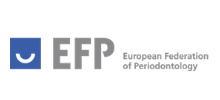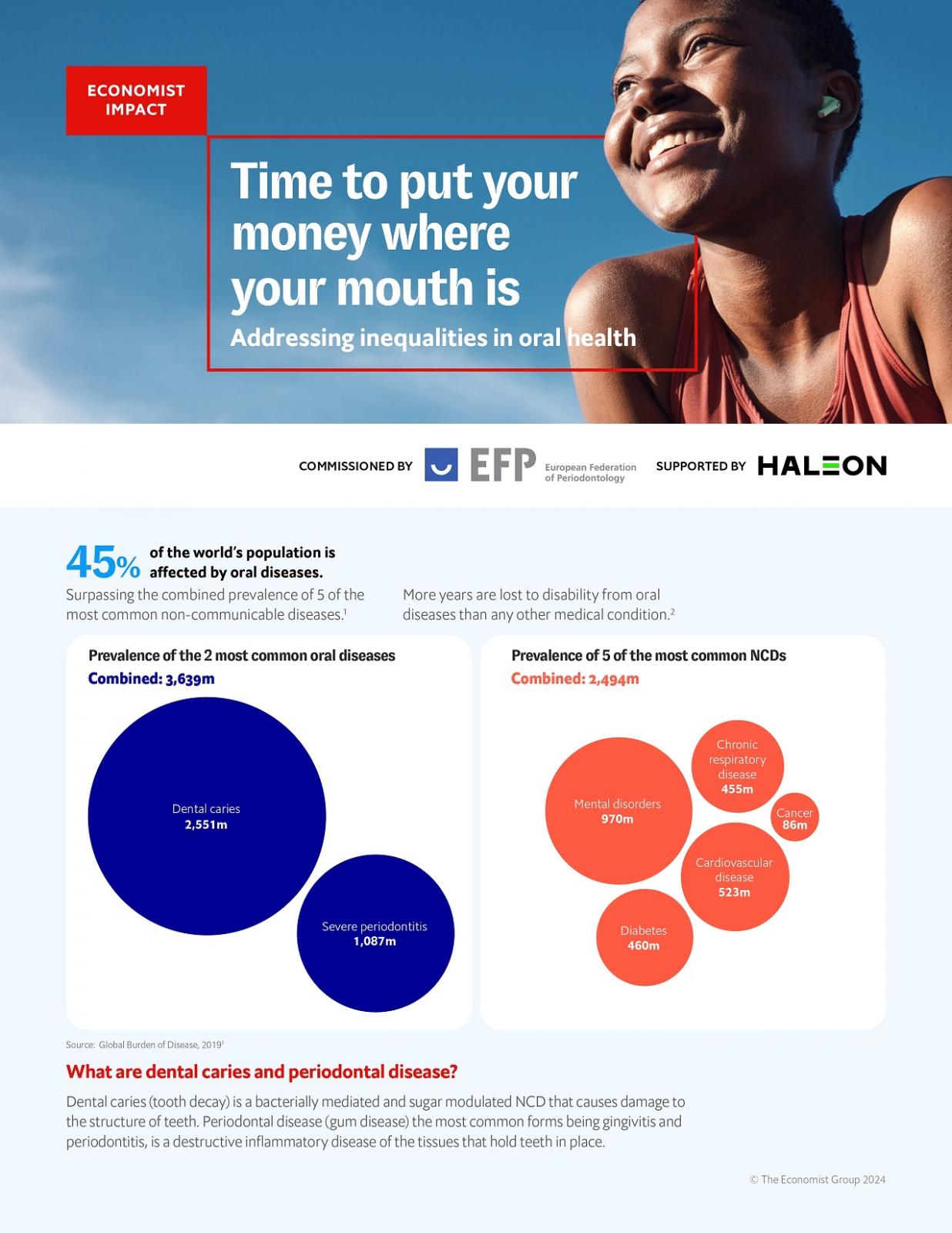Oral diseases have surpassed all other noncommunicable diseases (NCDs) in terms of their global prevalence. The most common oral diseases are caries and severe periodontitis, affecting about 2bn and 1bn people, respectively. Furthermore, these two highly prevalent diseases have a disproportionate impact on countries and populations with lower socioeconomic status. Socioeconomic deprivation is associated with lower awareness of oral self-care measures, increased intake of sugary foods and drinks that propagate these conditions, higher malnutrition rates and lower access to individual-level preventive measures and products such as toothbrushes, dental floss, interdental brushes, and fluoridated toothpaste or professionally applied fluoride varnish. These vulnerable populations also suffer poor access to treatment.
Time to put your money where your mouth is: addressing inequalities in oral health is a novel effort to look at both periodontitis and caries in an integrated fashion. The report examines the inequalities in oral health, the factors contributing to this unequal burden, and the opportunities available to level up oral health.
Our previous white paper examining the societal and economic impact of periodontitis reported that the highest impact was on those with the greatest social deprivation. However, there are also deficiencies in our understanding of the longitudinal health and economic impact of dental caries. While it’s known that people in lower socioeconomic groups experience the greatest health burden from caries, the disparities in the economic impact between different socioeconomic groups are not well studied. The extent of gains that can be achieved with effective upstream and downstream preventive measures also remains unclear. A better understanding of the health and cost implications could mobilise policy efforts to expand the application of preventive interventions and mitigate inequities. Therefore, we developed the “caries prevention and care cost” calculator. This calculator aims to: 1) estimate the direct costs of management of dental caries between the ages of 12 and 65 years across different socioeconomic groups and 2) the potential reduction in these costs from oral health-promoting interventions. Six countries were included in the assessment: Brazil, France, Germany, Indonesia, Italy, and the United Kingdom (UK). Due to lack of information regarding healthcare system costs in the public sector, private sector costs were used to estimate the burden.
Key findings
- Mainstream framing of oral diseases as NCDs is lacking - There has been a monumental shift in our understanding of periodontal disease and caries – they are no longer viewed as communicable diseases that are caused by microbes. We now understand that a beneficial balance of microbes is seen in the mouths of healthy individuals. Excessive intake of sugary foods promotes the growth of acid-loving or acid-tolerating (cariogenic) bacteria in dental plaque. These bacteria metabolise the sugars and other fermentable carbohydrates, producing acids that damage tooth surfaces and cause caries. Gingivitis (inflammation of the gums) drives the emergence of disease-forming microbes, which, in susceptible people, then leads to periodontitis. Individual susceptibility is governed by several risk factors, some of which are shared with other NCDs. Therefore, periodontitis and caries are now classified as NCDs that are largely preventable.
In 2021, the World Health Organization (WHO) adopted a Resolution on oral health, which recommended pivoting to a preventive approach for oral diseases and integrating oral care with NCDs care into the universal health care (UHC) agenda. Yet, the current mainstream framing of NCDs that prioritises five NCDs (mental disorders, cardiovascular diseases, diabetes, cancers and chronic respiratory diseases), and their risk factors, pays no attention to oral diseases or their main risk factor – simple/refined sugars.
- Barriers exist to implementing upstream and downstream preventive measures - At the population-level, community water fluoridation, the use of sugar taxes and community or school-based oral health education programmes are effective measures for lowering oral disease burden. At the individual-level, tooth brushing (that effectively removes plaque) twice a day with a toothpaste containing 1000-1500ppm of fluoride, as well as daily interdental cleaning (cleaning between teeth), prevent or delay development and progression of caries and periodontal diseases. The application of regular fluoride varnish or the use of sealants prevents/delays caries, while smoking cessation and controlling blood glucose improves periodontitis outcomes. However, there remain several barriers to the implementation of these measures.
While community water fluoridation is practised in Brazil and certain regions of the UK, other countries like Germany, France and Indonesia do not utilise this measure. A combination of factors such as the lack of political will, geographical difficulties due to the diversity of terrain and people using alternate sources such as well water for drinking pose challenges to fluoridation of water. France was one of the first European countries to introduce a sugar tax. The UK introduced a Soft Drinks Industrial Levy in 2018. Brazil introduced a tax on Sugar-Sweetened Beverages (SSB) in 2013, but contrary to global trends, the Brazilian government lowered the SSB tax rates in 2016 and 2018. Italy proposed a sugar tax in 2020, but strong opposition from corporate players has delayed its implementation. School-based preventive health programmes are commonplace in our countries of study, but they have been impacted by school closures during the pandemic. There is a push to start oral health education much earlier, as early as during pregnancy, as part of a true life-course approach to improve oral health. But more needs to be done in this regard.
- Clinical care for dental caries remains largely focused on a “repair approach” - Decades of oral care have focused on a restorative-reparative approach for what we understand now to be a largely preventable disease. Oral health professionals lack training in preventive care and their remuneration continues to perversely incentivise a surgical approach, giving birth to the phrase “drilling, filling and billing”. Besides remuneration models, workforce limitations also pose challenges to the preventive approach. Currently, only ~23% of the global population is estimated to have access to oral health services. Access is particularly poor in low-income countries and populations, as well as in rural areas. Many adults, especially in lower socioeconomic groups, never see a dentist in their lifetime, except for emergency care. While there are several allied health professionals such as dental therapists, hygienists and dental nurses with enhanced skills who can expand coverage, they are not uniformly recognised as formal members of the dental care workforce in many countries.
- The most deprived bear the highest costs of inadequate preventive efforts - In our modelling study, at the population-level, the overall direct costs of caries, in people 12-65 years of age, varied from $10,284bn in Italy to $36,231bn in Brazil; the difference is partly explained by differences in population sizes. The largest per-person costs were estimated in the UK at $22,910 and the lowest in Indonesia at $7,414. A disproportionately high burden of direct costs was seen among the most deprived populations across Brazil, France, Italy and the UK. More deprived populations often experience suboptimal or inappropriate treatment options due to their inability to afford better options; for example, undergoing a tooth extraction when a restorative procedure may be more appropriate or receiving a lower-cost replacement tooth or foregoing any replacement. Despite accounting for this in the model, the more deprived populations were still estimated to experience a larger economic burden from dental caries than the other deprivation groups. In Germany and Indonesia, the per-person costs were highest in the least deprived, followed closely by the most deprived, which is likely explained by the high cost of dental implants in these countries.
We then modelled the impact of preventive interventions on lowering caries-related direct costs. A combination of upstream and downstream interventions for prevention was envisioned that would facilitate a reduction of 30% in the annual caries progression rate. With these interventions, the greatest reduction in per-person costs was seen in the most deprived group in all countries except Indonesia. Using a levelling-up approach, where interventions applied are proportional to the need and the caries progression rate of the least deprived group is applied to all individuals, the per-person reduction in direct costs among the most deprived groups ranged from $3,948 in Indonesia to $17,728 in the UK. These data make a strong argument for instituting preventive management with a particular focus on narrowing the gap between the highest and lowest socioeconomic groups.
Explore our findings in the full report and infographic.
Click below to download the infographic.







